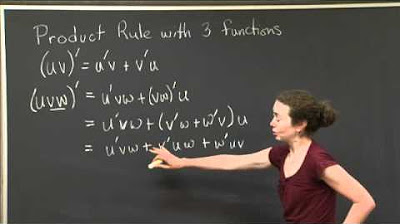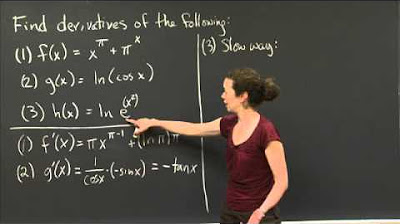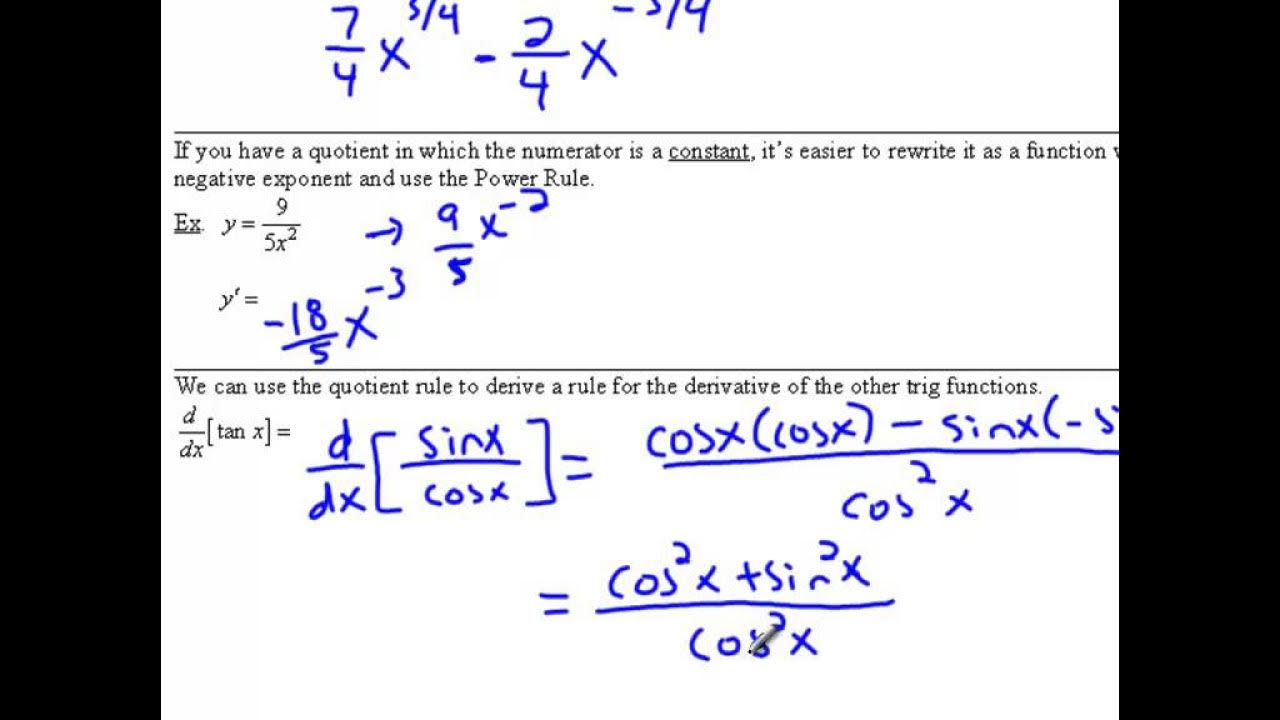Rules of Logs | MIT 18.01SC Single Variable Calculus, Fall 2010
TLDRIn this educational video, Professor Christine Breiner introduces and explains the fundamental rules of logarithms, including the product, quotient, and power rules, as well as the change of base formula. She demonstrates the proof of the product rule using exponential functions and their inverses. The video then transitions to applying these logarithmic principles to derive the derivative of a function using the log differentiation technique. The example provided is the derivative of the square root of \( x \) times \( x + 4 \), with a step-by-step walkthrough of the process.
Takeaways
- 📚 The lecture introduces logarithm rules essential for calculus, emphasizing their importance in differentiating functions.
- 🔍 The first three logarithm rules are explained with the natural logarithm but can be applied to any base provided it remains consistent.
- 📈 Logarithm of a product is the sum of the logarithms, which is a fundamental rule for combining logarithmic expressions.
- 📉 The logarithm of a quotient is the difference of the logarithms, highlighting the inverse relationship between multiplication and division in logarithmic form.
- ⏫ The logarithm of a number raised to a power is the exponent multiplied by the logarithm of the base, a key rule for simplifying expressions with exponents.
- 🚫 A clarification is made that the power rule for logarithms only applies when the exponent is inside the argument, not outside.
- 🔄 The change of base formula allows for converting logarithms from one base to another, specifically using natural logarithms.
- 🤔 A common mistake is pointed out regarding the confusion between the quotient of logarithms and the logarithm of a quotient.
- 📝 The proof of the product rule for logarithms is demonstrated using properties of exponential functions and their inverse relationship with logarithms.
- 🔧 Log differentiation is introduced as a technique for finding derivatives, particularly useful for complex functions involving products and roots.
- 🧭 An example is given to illustrate the use of log differentiation, showing the process of taking the derivative of a function involving a square root and a linear term.
Q & A
What is the main topic discussed in the script?
-The main topic discussed in the script is the rules of logarithms, their proofs, and the application of these rules in taking the derivative of a function using the log differentiation technique.
What are the first three logarithmic rules mentioned in the script, and what base can they be written in?
-The first three logarithmic rules mentioned are: (1) the natural log of a product is equal to the sum of the natural logs, (2) the natural log of a quotient is equal to the difference of the natural logs, and (3) the natural log of something raised to a power is the power times the natural log of the base. These rules can be written in any base as long as the base is the same throughout the expression and the base is positive.
Why is it incorrect to apply the third logarithmic rule when the power is outside the argument?
-The third logarithmic rule states that the natural log of something raised to a power is the power times the natural log of the base, but this rule only applies when the power is inside the argument. If the power is outside the argument, such as in the expression log(M^N), this rule does not hold and the expression is not equal to N times the log of M.
What is the change of base formula for logarithms, and how is it different from the second rule?
-The change of base formula states that log base b of M can be rewritten in base e as the natural log of M divided by the natural log of b. This is different from the second rule, which is about the natural log of a quotient, because the change of base formula is about the quotient of natural logs, not the natural log of a quotient.
How does the script prove the first logarithmic rule using exponential functions?
-The script proves the first logarithmic rule by setting M and N as e to the power of a and e to the power of b, respectively, where a is the natural log of M and b is the natural log of N. It then shows that the natural log of M times N is equal to the natural log of e to the power of (a + b), which simplifies to a + b, matching the natural log of M plus the natural log of N.
What is the function given in the script to find the derivative using the log differentiation technique?
-The function given in the script is y = the square root of x times (x + 4), where x is assumed to be greater than 0.
How does the script suggest simplifying the expression for the derivative using logarithmic rules?
-The script suggests taking the natural log of both sides of the equation, then using the logarithmic rules to simplify the right-hand side, particularly bringing the power of 1/2 out in front of the log and using the rule for the natural log of a product to separate it into the sum of natural logs.
What is the significance of taking the derivative of the natural log of y with respect to x in the script?
-The significance is to find y prime (the derivative of y). The derivative of the natural log of y with respect to x is y prime over y, which is then used to find the derivative of the simplified expression involving x.
How does the script differentiate between the derivative of the natural log of x and the natural log of x plus 4?
-The script differentiates between the two by applying the derivative of the natural log of x, which is 1/x, and the derivative of the natural log of (x + 4), which uses the chain rule and results in 1/(2*(x + 4)) after simplification.
What is the final expression for y prime obtained in the script?
-The final expression for y prime is y times the sum of 1/(2x) and 1/(2*(x + 4)), which can be written as y * (1/(2x) + 1/(2*(x + 4))).
Outlines
📚 Introduction to Logarithm Rules and Derivative with Logarithms
Christine Breiner introduces the session by focusing on logarithm rules essential for calculus. She emphasizes the first three rules apply to natural logarithms but can be adapted for any base, provided it remains consistent. The rules discussed are: the product rule, which equates the natural log of a product to the sum of the individual natural logs; the quotient rule, which states the natural log of a quotient equals the difference of the individual natural logs; and the power rule, which relates the natural log of a number raised to a power to the power multiplied by the natural log of the number. A distinction is made about the placement of the power in relation to the logarithm for the rules to apply. The change of base formula is also explained, converting any base logarithm to a natural logarithm by dividing the natural log of the argument by the natural log of the base. A common mistake of confusing the quotient rule with the change of base formula is pointed out. The session continues with a proof of the product rule using properties of exponential functions, demonstrating the equivalence of the natural log of a product to the sum of the natural logs. The instructor suggests that students attempt to prove the other rules independently, hinting at the use of different exponent rules. The session concludes with an application of these logarithm rules to find the derivative of a function involving a square root and a linear term, using the log differentiation technique.
🔍 Applying Logarithmic Differentiation to Find a Derivative
In this segment, the focus shifts to applying the logarithmic differentiation technique to find the derivative of a function y, which is defined as the square root of x times x plus 4, with the assumption that x is greater than zero. The instructor guides the students to first take the natural log of both sides of the equation to simplify the expression using logarithmic rules. The square root is interpreted as a power of 1/2, and the product inside the logarithm is rewritten using the power rule to bring the 1/2 coefficient outside the logarithm. The natural log of the product is then split into the sum of the natural logs of x and (x + 4). The derivative of the natural log of y with respect to x is found by differentiating each term and applying the chain rule, resulting in an expression involving y prime over y. The final step involves multiplying the derivative by y to isolate y prime, leading to an expression for the derivative that includes the original function y and its simplified form. The instructor suggests that while this method is a shortcut, it's also beneficial to understand the process of combining terms to find a cleaner expression for the derivative.
Mindmap
Keywords
💡Logarithm
💡Natural Logarithm
💡Logarithmic Rules
💡Product Rule
💡Quotient Rule
💡Power Rule
💡Change of Base Formula
💡Exponential Functions
💡Derivative
💡Logarithmic Differentiation
💡Implicit Differentiation
Highlights
Introduction to logarithm rules that are essential for calculus and their proof.
Logarithm rules can be applied to any base, as long as the base remains consistent throughout the expression.
The natural log of a product is the sum of the natural logs, demonstrated with the formula ln(MN) = ln(M) + ln(N).
The natural log of a quotient is the difference of the natural logs, shown as ln(M/N) = ln(M) - ln(N).
Power rule for logarithms states ln(M^k) = k * ln(M), where the power is inside the argument of the logarithm.
Clarification on the difference between the power inside the argument and outside, affecting the application of logarithm rules.
Change of base formula for logarithms, allowing conversion from any base to natural log, presented as log_b(M) = ln(M) / ln(b).
Common mistake warning about confusing the quotient of logs with the log of a quotient.
Proof of the product rule for natural logarithms using properties of exponential functions.
Demonstration of how to set up the proof by expressing M and N in terms of exponential functions with base e.
Use of inverse properties of exponential and logarithmic functions to simplify the proof.
Derivation of the logarithm of a product into a sum of logarithms through exponent manipulation.
Final proof conclusion showing ln(MN) equals ln(M) + ln(N), reinforcing the logarithm product rule.
Suggestion to attempt proving other logarithm rules using similar methods for deeper understanding.
Introduction of log differentiation technique to find the derivative of a function involving a product and a power.
Application of log differentiation to the function y = √(x) * (x + 4) to find its derivative.
Step-by-step walkthrough of taking the natural log of both sides of the equation and simplifying using logarithm rules.
Differentiation of the simplified logarithmic expression to find y', the derivative of y.
Final expression for y' derived using log differentiation, showcasing an alternative to traditional differentiation methods.
Transcripts
Browse More Related Video

Math 11- Section 2.6 (previously section 3.5)

Product Rule | MIT 18.01SC Single Variable Calculus, Fall 2010

Log and Exponent Derivatives | MIT 18.01SC Single Variable Calculus, Fall 2010

Implicit Differentiation Second Derivative Trig Functions & Examples- Calculus

Logarithmic Differentiation | Example: x^sinx

Product and Quotient Rule
5.0 / 5 (0 votes)
Thanks for rating: